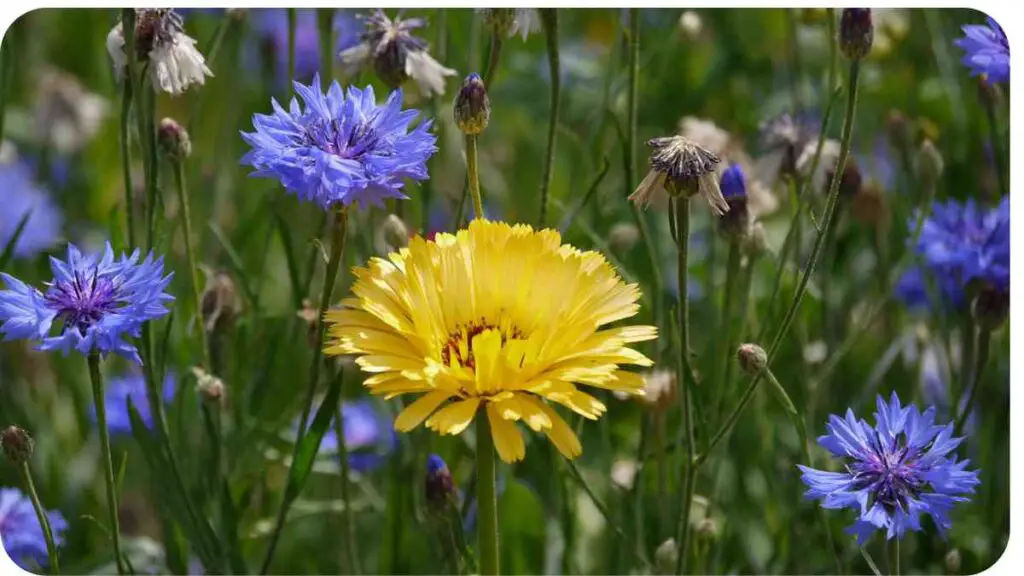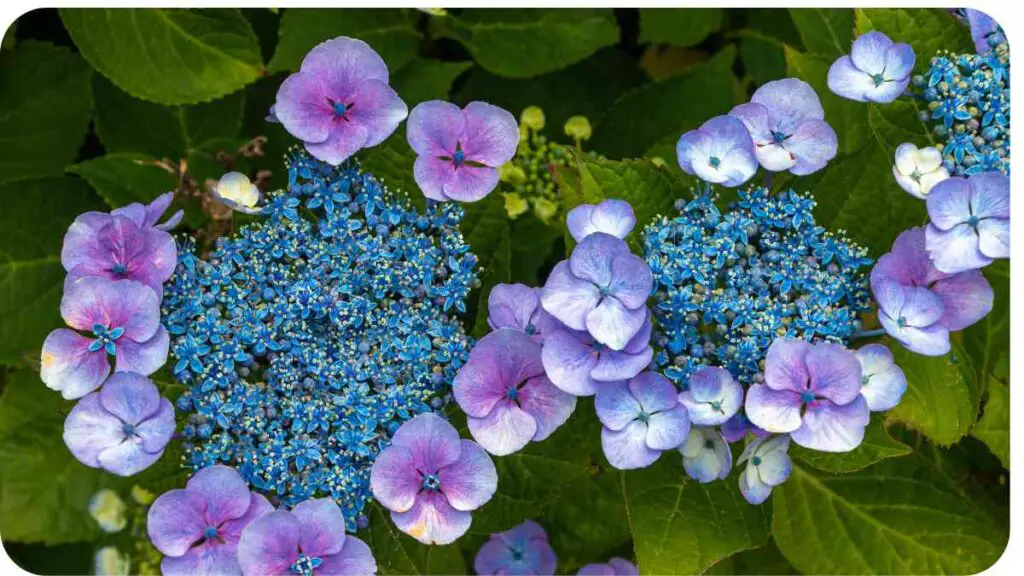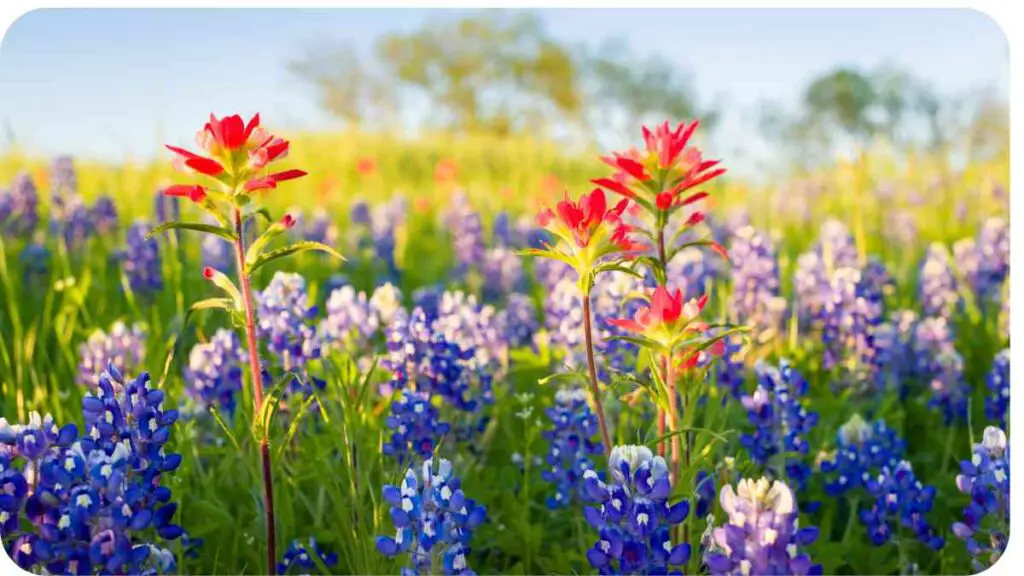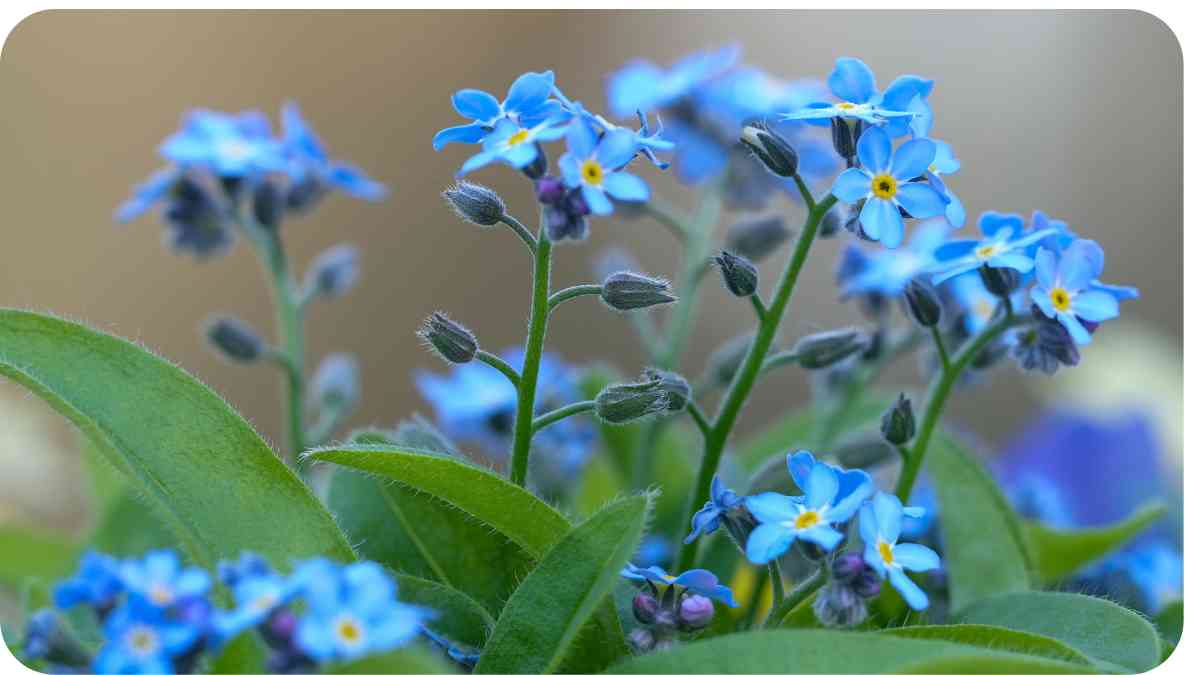Blue flowers are a rare and captivating sight in gardens around the world. Their elusive color adds a sense of mystery and tranquility to any landscape. Whether you’re an avid gardener or simply appreciate the beauty of nature, exploring the diversity of blue flowers can be a rewarding journey.
In this article, we delve into various types of blue flowers, from perennials to exotic varieties, offering insights into their characteristics, growing tips, and cultural significance.
| Takeaways |
|---|
| 1. Explore a variety of popular blue flowers, including perennials, annuals, shrubs, climbers, bulbs, wildflowers, and exotic varieties. |
| 2. Learn practical tips for growing and maintaining blue flowers, such as soil requirements, sunlight preferences, and pest control strategies. |
| 3. Discover the cultural significance of blue flowers in art, literature, and symbolism across different cultures. |
| 4. Find inspiration for incorporating blue flowers into your garden design to create a serene and vibrant outdoor space. |
| 5. Access further reading and resources to deepen your knowledge and enhance your gardening skills with blue flowers. |
Why Blue Flowers Are Unique

The color blue in flowers is often associated with serenity, peace, and harmony. Unlike more common flower colors like red or yellow, blue flowers are relatively rare in nature, making them highly sought after by garden enthusiasts. Their unique hue stands out in gardens and floral arrangements, providing a refreshing contrast to other colors. Blue flowers also hold symbolic meanings across cultures, representing loyalty, trust, and introspection.
Dandelions can surprise you with their benefits expert advice for natural yard care, offering ecological advantages alongside their vibrant blooms.
Popular Types of Blue Flowers
Table: Comparison of Popular Blue Flowers
| Flower Name | Type | Height (inches) | Blooming Season | Special Features |
|---|---|---|---|---|
| Blue Hydrangea | Shrub | 36-60 | Summer | Large, clustered blooms |
| Delphinium | Perennial | 24-72 | Summer | Tall spikes of blue flowers |
| Forget-Me-Not | Annual | 6-12 | Spring to Summer | Tiny, delicate blossoms |
| Bachelor’s Button | Annual | 12-36 | Summer | Vibrant blue, easy to grow |
| Morning Glory | Climber | Up to 120 | Summer to Fall | Fast-growing vine |
Blue flowers come in various forms, each with its own charm and growing requirements. Let’s explore some of the most popular types in detail.
Perennials
Perennial blue flowers are beloved for their ability to return year after year, adding reliable color to garden beds and borders.
Characteristics of Perennial Blue Flowers
Perennial blue flowers, such as the majestic Delphinium and elegant Blue Veronica, are known for their robust nature and vibrant blooms. These flowers often require well-drained soil and full sun to thrive, making them ideal for creating long-lasting garden displays.
Considering planting elm trees? Explore their yard landscaping benefits and how they can enhance your outdoor space with shade and resilience.
Table: Top Perennial Blue Flowers
| Flower Name | Height (inches) | Blooming Season | Sunlight | Water Needs |
|---|---|---|---|---|
| Delphinium | 24-72 | Summer | Full sun | Moderate |
| Blue Veronica | 12-36 | Spring to Fall | Full sun to part shade | Low to moderate |
| Siberian Iris | 18-36 | Spring | Full sun to part shade | Moderate to high |
Perennial blue flowers offer enduring beauty and require minimal maintenance once established, making them a favorite among gardeners.
Annuals
Annual blue flowers provide bursts of color throughout the growing season and are perfect for filling in garden gaps or adding accents to flower beds.
Discover why ash trees are valued for yard landscaping and how their majestic stature and environmental benefits can elevate your property’s landscape.
Advantages of Growing Annual Blue Flowers
Annual blue flowers like Forget-Me-Nots and Bachelor’s Buttons are prized for their easy cultivation and continuous blooming. These flowers thrive in various conditions and often self-seed, ensuring a new crop of blooms each year.
Table: Best Annual Blue Flowers for Gardens
| Flower Name | Height (inches) | Blooming Season | Sunlight | Water Needs |
|---|---|---|---|---|
| Forget-Me-Not | 6-12 | Spring to Summer | Part shade | Moderate |
| Bachelor’s Button | 12-36 | Summer | Full sun | Low to moderate |
| Lobelia | 6-12 | Spring to Fall | Part shade to full sun | Moderate |
Annual blue flowers are versatile and add instant charm to any garden setting, making them a favorite among both novice and experienced gardeners alike.
Shrubs and Bushes
Blue flowering shrubs and bushes offer structural interest and a splash of color to garden landscapes, providing year-round appeal.
Choosing Blue Flowering Shrubs

Blue hydrangeas and ceanothus are popular choices for gardeners seeking bold, statement-making shrubs. These plants often require acidic soil and benefit from regular pruning to maintain their shape and promote healthy growth.
Explore a variety of flowers with delightful fragrances, perfect for enhancing your garden or home with their aromatic allure and natural charm.
Table: Blue Flowering Shrubs Comparison
| Shrub Name | Height (feet) | Blooming Season | Sunlight | Soil pH |
|---|---|---|---|---|
| Blue Hydrangea | 3-5 | Summer | Part shade to full sun | Acidic |
| Ceanothus | 3-10 | Spring to Summer | Full sun | Neutral to acidic |
Blue flowering shrubs are a cornerstone of many garden designs, providing both beauty and structure to outdoor spaces.
Climbers and Vines
Climbing blue flowers add vertical interest to gardens, covering walls, trellises, and pergolas with their lush foliage and vibrant blooms.
Using Blue Flowers in Vertical Gardens
Morning Glory and Clematis are popular choices for vertical gardening enthusiasts, offering rapid growth and abundant flowers throughout the season. These climbers thrive in sunny locations with well-drained soil, making them ideal for creating vertical accents in garden landscapes.
Table: Climbing Blue Flowers
| Flower Name | Height (feet) | Blooming Season | Sunlight | Water Needs |
|---|---|---|---|---|
| Morning Glory | Up to 120 | Summer to Fall | Full sun | Low to moderate |
| Clematis | 6-12 | Spring to Fall | Full sun to part shade | Moderate |
| Blue Passionflower | 10-20 | Summer to Fall | Full sun | Low to moderate |
Climbing blue flowers not only enhance vertical spaces but also attract pollinators, adding life and color to garden areas.
Bulbs and Tubers
Blue flower bulbs and tubers offer early-season blooms and are a delight for gardeners looking to start their gardens with a burst of color.
Planting Blue Flower Bulbs
Bluebell and Iris bulbs are favorites among gardeners for their stunning blooms and ease of cultivation. These bulbs thrive in well-drained soil and partial shade, making them suitable for woodland gardens or mixed borders.
Table: Bulbous Blue Flowers
| Flower Name | Height (inches) | Blooming Season | Sunlight | Soil Type |
|---|---|---|---|---|
| Bluebell | 8-16 | Spring | Part shade | Moist, well-drained |
| Iris | 6-36 | Spring to Summer | Full sun to part shade | Well-drained |
| Glory of the Snow | 4-6 | Spring | Full sun to part shade | Well-drained |
Planting blue flower bulbs adds early-season color and diversity to garden beds, creating a vibrant tapestry of blooms.
Wildflowers

Blue wildflowers add a natural charm to landscapes, thriving in diverse environments and providing essential habitats for local wildlife.
Blue Flowers in Natural Landscapes
Wildflowers like Blue Flax and Chicory are beloved for their resilience and ability to thrive in various soil conditions. These native plants attract pollinators and offer sustainable beauty to meadows, roadside plantings, and native garden settings.
Table: Native Blue Wildflowers
| Flower Name | Height (inches) | Blooming Season | Sunlight | Soil Type |
|---|---|---|---|---|
| Blue Flax | 12-36 | Summer | Full sun | Well-drained |
| Chicory | 24-48 | Summer to Fall | Full sun | Well-drained |
| Blue-eyed Grass | 6-18 | Spring to Summer | Full sun to part shade | Moist, well-drained |
Blue wildflowers play a crucial role in ecological restoration and provide aesthetic value to natural landscapes.
Exotic Varieties
Exotic blue flowers captivate with their unique shapes, colors, and cultural significance, adding a touch of intrigue to gardens worldwide.
Rare and Unique Blue Flowers
Exotic blue flowers like Himalayan Blue Poppy and Gentian showcase rare beauty and require specialized care to thrive. These plants often hail from distant corners of the globe, captivating gardeners with their enchanting blooms.
Table: Exotic Blue Flowers Around the World
| Flower Name | Height (inches) | Blooming Season | Sunlight | Special Care |
|---|---|---|---|---|
| Himalayan Blue Poppy | 24-36 | Summer | Part shade | Moist, cool climate |
| Gentian | 6-24 | Summer to Fall | Full sun to part shade | Well-drained |
| Blue African Lily | 12-36 | Spring to Summer | Full sun | Moderate water |
Exotic blue flowers offer a glimpse into distant botanical realms, enriching gardens with their rare and captivating allure.
Caring for Blue Flowers
Proper care is essential to maintain the health and vibrancy of blue flowers throughout the growing season, ensuring optimal growth and abundant blooms.
Tips for Growing and Maintaining Blue Flowers
- Soil and Sunlight: Most blue flowers prefer well-drained soil with moderate moisture levels. Ensure they receive adequate sunlight based on their specific requirements.
- Watering: Water deeply but infrequently to encourage deep root growth and prevent waterlogging, which can be detrimental to many blue flowers.
- Fertilization: Use a balanced fertilizer formulated for flowering plants to promote healthy foliage and vibrant blooms.
- Pruning: Regular deadheading and pruning can prolong blooming periods and maintain plant shape, especially for shrubs and perennials.
- Pest and Disease Control: Monitor for common pests like aphids and caterpillars, and promptly address any signs of disease to prevent spread.
Blue Flowers in Art and Symbolism
Blue flowers have long been celebrated in art, literature, and symbolism, evoking emotions and cultural significance across different societies.
Cultural Significance of Blue Flowers
Blue flowers symbolize various meanings, including tranquility, spirituality, and hope. In art and literature, they often represent unattainable beauty or profound emotions, making them a popular motif in paintings, poetry, and floral arrangements.
Conclusion
Exploring the world of blue flowers reveals a spectrum of beauty and diversity that enriches gardens and landscapes worldwide. Whether you’re drawn to the vibrant hues of annuals or the timeless elegance of perennials, incorporating blue flowers into your garden can create a tranquil and enchanting outdoor sanctuary.
Further Reading and Resources
For more information on growing blue flowers and incorporating them into your garden design, explore the following resources:
- Books on floral gardening and plant care
- Online forums and communities for gardeners
- Botanical gardens and nurseries specializing in blue flower varieties
Further Reading and Resources
- ProFlowers – Blue Flowers: Explore a comprehensive guide to blue flowers, including care tips and popular varieties.
- Planet Natural – Blue Flowers: Discover natural gardening techniques and tips for growing vibrant blue flowers in your garden.
- Epic Gardening – Blue Flowers: Learn about unique blue flower varieties and how to incorporate them into your garden design for maximum impact.
FAQs
What are the most popular types of blue flowers?
Blue flowers come in various types, with popular choices including hydrangeas, delphiniums, forget-me-nots, and morning glories.
How do I care for blue flowers in my garden?
Blue flowers generally prefer well-drained soil and moderate sunlight. Regular watering, fertilization, and occasional pruning are key to maintaining their health and vibrant blooms.
Can I grow blue flowers in pots or containers?
Yes, many blue flowers, such as lobelia and bluebell, thrive in containers with good drainage and sufficient sunlight. Ensure to use a suitable potting mix and provide regular care.
What are some symbolic meanings associated with blue flowers?
Blue flowers symbolize peace, tranquility, and serenity. They are often used to convey feelings of calmness and spiritual depth in floral arrangements and gardens.
How can I attract pollinators with blue flowers?
Blue flowers, particularly those with open shapes like salvias and veronicas, attract pollinators such as bees and butterflies with their nectar-rich blooms and vibrant colors.

I am Hellen James, a landscape architect. For many years I have written about landscaping for various publications; however, recently decided to focus my writing on personal experience as a profession.

